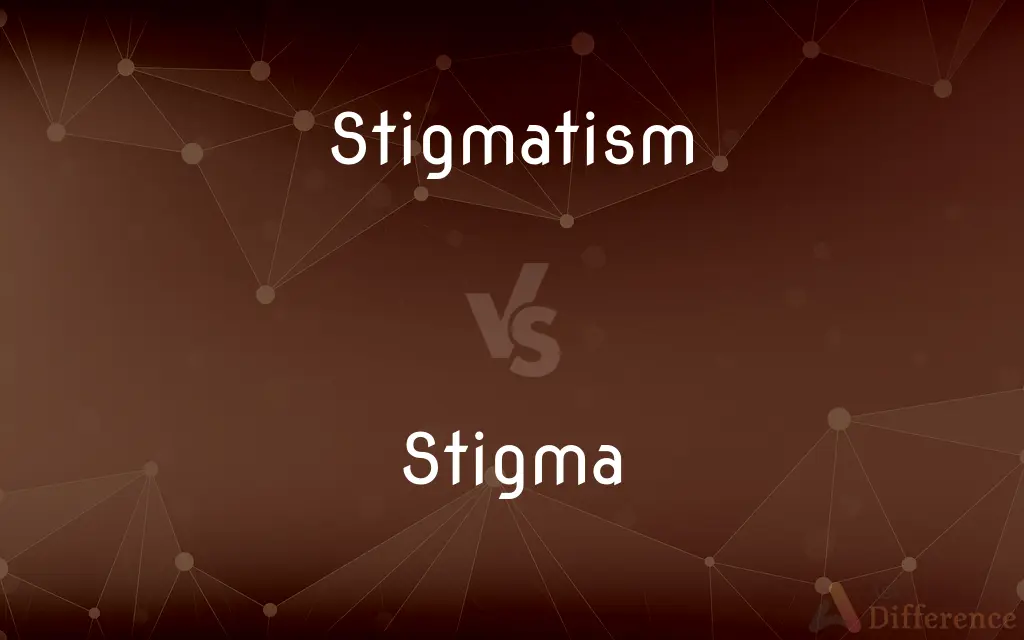Stigmatism vs. Stigma — What's the Difference?
Edited by Tayyaba Rehman — By Maham Liaqat — Updated on May 21, 2024
Stigmatism refers to a defect in the eye causing blurred vision, while stigma denotes a negative stereotype or social disapproval associated with a person or group.

Difference Between Stigmatism and Stigma
Table of Contents
ADVERTISEMENT
Key Differences
Stigmatism, also known as astigmatism, is an eye condition where the cornea or lens is irregularly shaped, causing distorted vision. This medical term describes a physical attribute that impacts how light enters the eye, leading to blurred or distorted images. Stigma, on the other hand, is a social concept related to the negative perception or discrimination against individuals based on certain characteristics or behaviors. This term often involves societal disapproval or prejudice, leading to marginalization or social exclusion.
Stigmatism directly impacts an individual's vision, requiring medical intervention for improvement. Correcting stigmatism involves optometric solutions, addressing the physical aspect of the condition to enhance visual clarity. Whereas stigma is more psychological and social, rooted in cultural and societal norms that perpetuate negative stereotypes. Addressing stigma requires changing societal attitudes and providing support to affected individuals, focusing on awareness, education, and empathy.
Stigmatism's effects are primarily physical, causing inconvenience and requiring medical treatment. The challenges it presents are more straightforward, involving optometric or surgical correction to improve daily life and visual functionality. On the other hand, stigma's effects are complex and multifaceted, often leading to emotional and psychological distress. Overcoming stigma involves broader societal changes, advocacy, and personal resilience, aiming to create an inclusive and understanding environment.
Comparison Chart
Definition
Eye defect causing blurred vision
Negative stereotype or social disapproval
Nature
Medical condition
Social concept
ADVERTISEMENT
Impact
Affects vision
Affects social and psychological well-being
Treatment
Glasses, contact lenses, surgery
Awareness, education, support
Cause
Irregularly shaped cornea or lens
Societal norms and prejudices
Compare with Definitions
Stigmatism
Another term for the same eye defect.
Her astigmatism caused her to see blurred images until she got glasses.
Stigma
A mark of disgrace associated with a particular circumstance.
The stigma around mental illness prevents many from seeking help.
Stigmatism
A specific type of vision problem involving distorted sight.
His stigmatism made it difficult to read without his glasses.
Stigma
An unfair negative attitude towards a person or group.
He faced stigma due to his background, affecting his opportunities.
Stigmatism
A common eye issue where the curvature of the eye is irregular.
The optometrist explained that stigmatism is a common refractive error.
Stigma
Negative societal views entrenched in cultural beliefs.
Overcoming the stigma of single parenthood requires changing cultural biases.
Stigmatism
A condition where the eye does not focus light evenly on the retina.
The doctor diagnosed him with stigmatism, requiring corrective lenses.
Stigma
An association of disgrace or public disapproval with something, such as an action or condition
"Depression ... has become easier to diagnose, and seeking treatment does not carry the stigma it once did" (Greg Critser).
Stigmatism
An irregular shape of the cornea leading to vision problems.
She learned that her vision problems were due to a corneal defect called stigmatism.
Stigma
A visible indicator of disease.
Stigmatism
In geometric optics, stigmatism refers to the image-formation property of an optical system which focuses a single point source in object space into a single point in image space. Two such points are called a stigmatic pair of the optical system.
Stigma
A small bodily mark, especially a birthmark or scar, that is congenital or indicative of a condition or disease.
Stigmatism
The condition of being affected by stigmata.
Stigma
(Psychology) A bleeding spot on the skin considered to be a manifestation of conversion disorder.
Stigmatism
The state of a refracting or reflecting system in which light rays from a single point are accurately focused at another point.
Stigma
Stigmata(Christianity) Bodily marks, sores, or sensations of pain corresponding in location to the crucifixion wounds of Jesus, believed to be given as divine recognition of devotion.
Stigmatism
Normal eyesight.
Stigma
(Botany) The apex of the pistil of a flower, on which pollen grains are deposited and germinate.
Stigmatism
(optics) Image-formation property of an optical system which focuses a single point source in object space into a single point in image space
Stigma
(Biology) A small mark, spot, or pore, such as the respiratory spiracle of an insect or an eyespot in certain protists.
Stigmatism
(medicine) Normal eyesight, anastigmatic state
Stigma
(Archaic) A mark burned into the skin as a visible identifier of a person as a criminal or slave; a brand.
Stigmatism
(pathology) State of having stigmata
Stigma
A mark of infamy or disgrace.
Stigmatism
The condition of having or being marked by stigmata
Stigma
A scar or birthmark.
Stigmatism
(optics) condition of an optical system (as a lens) in which light rays from a single point converge in a single focal point
Stigma
A mark on the body corresponding to one of the wounds of the Crucifixion on Jesus' body, and sometimes reported to bleed periodically.
Stigmatism
Normal eyesight
Stigma
An outward sign; an indication.
Stigma
(botany) The sticky part of a flower that receives pollen during pollination.
Stigma
(medicine) A visible sign or characteristic of a disease.
Stigma
(typography) A ligature of the Greek letters sigma and tau, (Ϛ/ϛ).
Stigma
A mark made with a burning iron; a brand.
Stigma
Any mark of infamy or disgrace; sign of moral blemish; stain or reproach caused by dishonorable conduct; reproachful characterization.
The blackest stigma that can be fastened upon him.
All such slaughters were from thence called Bartelmies, simply in a perpetual stigma of that butchery.
Stigma
That part of a pistil which has no epidermis, and is fitted to receive the pollen. It is usually the terminal portion, and is commonly somewhat glutinous or viscid. See Illust. of Stamen and of Flower.
Stigma
A small spot, mark, scar, or a minute hole; - applied especially to a spot on the outer surface of a Graafian follicle, and to spots of intercellular substance in scaly epithelium, or to minute holes in such spots.
Stigma
A red speck upon the skin, produced either by the extravasation of blood, as in the bloody sweat characteristic of certain varieties of religious ecstasy, or by capillary congestion, as in the case of drunkards.
Stigma
One of the external openings of the tracheæ of insects, myriapods, and other arthropods; a spiracle.
Stigma
A point so connected by any law whatever with another point, called an index, that as the index moves in any manner in a plane the first point or stigma moves in a determinate way in the same plane.
Stigma
Marks believed to have been supernaturally impressed upon the bodies of certain persons in imitation of the wounds on the crucified body of Christ. See def. 5, above.
Stigma
The apical end of the style where deposited pollen enters the pistil
Stigma
A symbol of disgrace or infamy;
And the Lord set a mark upon Cain
Stigma
An external tracheal aperture in a terrestrial arthropod
Stigma
A skin lesion that is a diagnostic sign of some disease
Stigma
A societal bias against certain groups or behaviors.
There is a strong stigma attached to being unemployed.
Stigma
Social exclusion based on perceived differences.
The stigma of poverty often leads to social marginalization.
Common Curiosities
How is stigma different from stigmatism?
Stigma is a social concept involving negative stereotypes, while stigmatism is a medical condition affecting vision.
Can stigma be reduced?
Yes, stigma can be reduced through education, awareness, and fostering an inclusive society.
Can stigmatism be corrected?
Yes, stigmatism can be corrected with glasses, contact lenses, or surgery.
Is stigmatism the same as astigmatism?
Yes, stigmatism and astigmatism refer to the same eye condition causing blurred vision.
What are the societal impacts of stigma?
Stigma can lead to discrimination, marginalization, and reduced opportunities for affected individuals.
What are the symptoms of stigmatism?
Symptoms include blurred vision, eye strain, and difficulty focusing on objects.
What are examples of stigma in society?
Examples include stigma around mental health, addiction, and certain diseases like HIV/AIDS.
What is stigmatism in medical terms?
Stigmatism refers to a defect in the eye, causing blurred or distorted vision due to irregular shape.
How does stigma develop in society?
Stigma develops through cultural norms, stereotypes, and societal prejudices against certain characteristics or behaviors.
What are the causes of stigmatism?
Stigmatism is caused by an irregularly shaped cornea or lens, leading to improper light focus.
How does stigma affect mental health?
Stigma can lead to emotional distress, social isolation, and reluctance to seek help, negatively impacting mental health.
Is stigmatism a common condition?
Yes, stigmatism is a common refractive error affecting many people.
What is the role of advocacy in reducing stigma?
Advocacy plays a crucial role in challenging stereotypes, promoting understanding, and supporting affected individuals.
Can children have stigmatism?
Yes, children can have stigmatism, which can be diagnosed and corrected with appropriate treatment.
Are there any long-term effects of untreated stigmatism?
Untreated stigmatism can lead to chronic eye strain and headaches, impacting overall quality of life.
Share Your Discovery

Previous Comparison
Accrue vs. Accumulate
Next Comparison
Founded vs. EstablishedAuthor Spotlight
Written by
Maham LiaqatEdited by
Tayyaba RehmanTayyaba Rehman is a distinguished writer, currently serving as a primary contributor to askdifference.com. As a researcher in semantics and etymology, Tayyaba's passion for the complexity of languages and their distinctions has found a perfect home on the platform. Tayyaba delves into the intricacies of language, distinguishing between commonly confused words and phrases, thereby providing clarity for readers worldwide.
















































